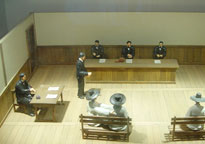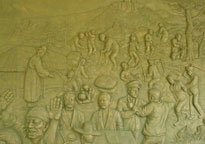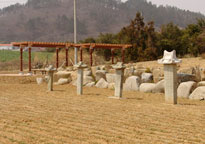
The intention is to refocus the history of the people in 3 Haeui areas (Haeui, Sangtae, & Hatae) staking their lives to take their lands back from the late Chosun era to the Independence from the Japanese for 360 years, succed their noble spirt of resistance and provide descendents and tourists with the vivid historical education.
Status of Facilities
- Address : 115, Haeui-ro, Haeui-myeon, Shinan-gun (35-9, Daeri)
- Project Scale: land 17,699㎡(5,350-pyeong), building 612㎡(185-pyeong)
- Budget: 2.9 billion KRW
- Inquiries : Tel 061-240-8877
- Exhibition facility & landscape facility
- Entrance area: general information center, information search room, lounge, image wall, etc.
- Land Resistance Memorial Room (3 areas) : land of history, land of resistance, and land of peace
- Farming Culture Room: local living of 3-Haeui-area, farming situation, Haeui-island tourism, etc.
- Outdoor symbolic sculpture & monument (1 area)

Inside of Exhibition Hall

Wall paining in commemoration
of Peasants' Movement

Peasants' Movement
Achievement Monument
Historical meaning of 3-Haeui-Area Peasants' Movement
"3- Haeui- Area Farmland Reclamation Movement was a representation of peasants' movment and struggle that held the peasants' desparate longing for their own land and representing the contradiction that the land issue had from Chosun era to the Japanese colonial period."
Most of the islands in the southwest sea were restricted from living until the irnjin war pursuant to the government's policy of having "vacant islands" for a safety reason. After the irnjin war when peaceful era came, people started to move to these islands. At that time, the land started to be cultivated.
According to the law of the Chosun dynasty, the ownership of the uncultivated land belonged to the one who cultivated the land. However, the kingdom took away the ownerships of so many pieces of lands being cultivated in the southwest coasts and gave away to the public officials.
At this time, the 24-gyeol cultivated lands 3 Haeui areas were given to princess Jeongmyeong (married to Hong family), daughter of King Seonjo(1552~1608) and the Hong family occupied the land and collected the tax. Since then, the Hong family became greedier and tried to occupy the land that was cultivated later.
The residents in 3 Haeui areas resisted but the upper-class family was so powerful and in the end, all the land of 3 Haeui areas belonged to the Hong family. At the end of Chosun, the ownerships of the lands were transferred from the Hong family to Naejangwon, then, back to the Hong family and then through several brokers, to a Japanese Wugeungeonjwawuimun and then to Deokjeonmichil.
During this period, the residents of 3 Haeui areas persisted resistance. They never acknowledged the owners of the lands from Hong family to Deokjeon and refused to pay the tax or rent and through various law-suits, and then through peasant association, they continued to resist. Finally, in 1950 after the liberation, the Congress decided the paid reclamation and in 1956, the lands were returned.
For almost 300 years, the residents in 3 Haeui areas conducted the resistance movement and it is one of the representations of peasants' resistances regarding the land issue in our history. This movement was different from several conflicts by peasant tenants in the neighboring islands, such as Amtae-island, during the Japanese colonial period. The land reclamation movement by 3 Haeui areas was the struggle that held the peasants' desparate longing for having their own land and clearly represented the contradiction regarding the land issue from Chosun era to the Japanese colonial period.
According to the law of the Chosun dynasty, the ownership of the uncultivated land belonged to the one who cultivated the land. However, the kingdom took away the ownerships of so many pieces of lands being cultivated in the southwest coasts and gave away to the public officials.
At this time, the 24-gyeol cultivated lands 3 Haeui areas were given to princess Jeongmyeong (married to Hong family), daughter of King Seonjo(1552~1608) and the Hong family occupied the land and collected the tax. Since then, the Hong family became greedier and tried to occupy the land that was cultivated later.
The residents in 3 Haeui areas resisted but the upper-class family was so powerful and in the end, all the land of 3 Haeui areas belonged to the Hong family. At the end of Chosun, the ownerships of the lands were transferred from the Hong family to Naejangwon, then, back to the Hong family and then through several brokers, to a Japanese Wugeungeonjwawuimun and then to Deokjeonmichil.
During this period, the residents of 3 Haeui areas persisted resistance. They never acknowledged the owners of the lands from Hong family to Deokjeon and refused to pay the tax or rent and through various law-suits, and then through peasant association, they continued to resist. Finally, in 1950 after the liberation, the Congress decided the paid reclamation and in 1956, the lands were returned.
For almost 300 years, the residents in 3 Haeui areas conducted the resistance movement and it is one of the representations of peasants' resistances regarding the land issue in our history. This movement was different from several conflicts by peasant tenants in the neighboring islands, such as Amtae-island, during the Japanese colonial period. The land reclamation movement by 3 Haeui areas was the struggle that held the peasants' desparate longing for having their own land and clearly represented the contradiction regarding the land issue from Chosun era to the Japanese colonial period.
Progress (2002 ~ Dec. 2005)
- Dec. 2002 start of construction
- Sept. 2003 request of the design of landscape
- Apr. 2004 completion of exhibition building and displays installation
- Dec. 2004 completion of additional facilities and landscape facilities
- Dec. 2005 completion of the 150m entrance road and its extension.
- Dec. 2005 completion of parking lot.

